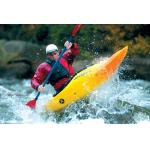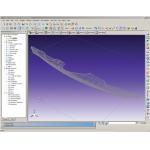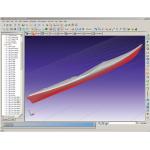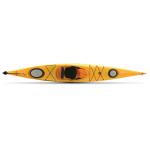Fast & Clean
3D scanning helps a kayak maker navigate between hand crafting and digital design.
Latest News
November 1, 2005
By Todd Grimm
3D scanning helps a kayak maker navigate between hand crafting and digital design.
Kayaking has two extremes—the slow, leisurely float and the adrenaline-pumping rush of whitewater paddling. For these extremes, and everything in between, Watermark Sports has just the right boat. Through its Dagger, Perception, and Mainstream product lines, it offers recreational, fishing, expedition, touring, whitewater, and freestyle kayaks.
Watermark introduces 12 to 18 new boats each year at the Outdoor Retailer Summer Market, and year–after–year, the industry honors Watermark’s kayaks. Most recently, its Dagger Crazy 88 freestyle boat won Outside magazine’s Gear of the Year award. The judging criteria included comfort, aerial capabilities, speed, predictability, control, and stability. Producing a boat that excels in all these categories requires a combination of skill, experience, and craftsmanship. It also demands the right tools.
 |
| Photo by Charlie Munsey |
Watermark designs their boats using both digital design tools and model-making skills. To bridge the gap between hand-crafted prototypes and CAD data, the company depends on its reverse engineering tools, a Konica Minolta Vivid 910 laser scanner and RapidForm 3D scan data-processing software. According to David Maughan, product designer at Watermark, “Our reverse engineering tools are a great asset for any boat that we’re developing.”
Building a Boat
Design of a new boat begins with CAD. In the digital world, Watermark applies its years of experience to develop a product that both looks great and performs well. But experience, knowledge, and computer programs cannot predict a boat’s handling and stability. So after a designer has done his job at the computer, the design must be refined for peak performance. To do this, Watermark must put a prototype boat in the water.
The prototype, which is called a plug, is milled from high-density foam by a CNC machine. Watermark’s design team puts the full-scale model in the water and takes it out for a paddle. The test run provides performance data and highlights needed modifications. The prototype is then pulled from the water and sent to the model shop, where it is reshaped by hand. At this point, experienced model-makers take over and adjust the hull’s contours with hand rasps, sandpaper, other shaping tools, and body filler.
After repeated testing and reshaping, the design team settles on the perfect boat. The boat, however, exists only as a physical model that is an alteration of its original CAD model. To bridge the gap and get a CAD model from which to manufacture a line of boats, Watermark digitally scans the plug to capture its design modifications.
 |
| The point cloud for half of the Carolina kayak’s hull contains 2.5 million points. |
In the past, Watermark used a touch probe CMM tool mounted on an articulated arm. The problem was that it took as much as a week to gather the data and incorporate the modifications in a new CAD model. And due to time constraints and the manual operation of the touch probe, the input was limited to a few hundred discrete data points. With so little data, the CAD model did not capture all of the subtle contours hand-worked by the model-makers and the finished product often lacked many of the performance-enhancing alterations and some of their cosmetic appeal.
To speed up the process and get more accurate scans, Watermark selected Konica Minolta’s Vivid 910 laser scanner and INUS Technology’s RapidForm software for the 2005 model year boats.
“We didn’t want our boat designs to be dictated by what the software can do,” says Maughan. “With RapidForm we have control over the end result.” And despite the system’s robustness and comprehensive nature, it was easy to get started. “I didn’t feel that it was that hard to dive in, start playing with RapidForm, and figure it out,” says Maughan. He also noted that the support he received from his reseller and INUS Technology provided answers to all the questions that he had.
Watermark now captures design changes to its plugs in just three hours, a process that took a week the old way. In addition to the faster processing, the combination of the new hardware and software means increased data accuracy as well as additional control over the scanned data.
The Process
Watermark begins by scanning one-half of the plug, the data from which is later mirrored to create perfect symmetry. Each plug will yield between 20 and 40 scans over the length of the kayak, which ranges from 7 to 19 feet. Although the Vivid 910 scanner can capture 307,000 points per scan, Maughan has found that the fast mode, which captures 77,000 points in 0.3 seconds, provides all the detail and speed that he needs. “I am amazed at how accurate it is even though we are only using a one-quarter scan,” says Maughan. Scanning a seven-foot boat takes 45 minutes.
 |
| In RapidForm, the point cloud is processed to yield a smooth polygonal data file that captures all of the hand-worked detail. |
After scanning the plug, Watermark imports the point cloud data into RapidForm. The scan data is then cleaned up, registered, and aligned. The length of a boat and the soft contours of the hull make this one of toughest applications for scan alignment. Yet, RapidForm completes the alignment easily—with some minor adjustments by Maughan. Using the RapidForm tools, Watermark gets an accurate digital model from the collected data in an hour.
Once the digital definition is complete, the data is exported to the company’s CAD software. First, Maughan creates NURBS surfaces in RapidForm. He then selects the desired data by turning off shells that are not required and exports the surfaced data in IGES format. Maughan says the IGES data import is simple and that he has never had a problem bringing the 3D data into his CAD application.
 |
| Prior to export, the scanned data is converted into NURBS surfaces. Then desired data is selected and surfaced data is exported in IGES format. |
In the CAD package, Maughan then creates the mirror image of the data to create a complete boat hull with perfect symmetry. From this file he creates his toolpaths and then machines another full–size plug in high-density foam. This new plug becomes the pattern for casting a composite tool used for rotational molding or vacuum forming a kayak.
“We progress to the next generation of a boat or to a different size of boat much faster than we have ever been able to do before,” notes Maughan. Expanding Abilities
Another benefit of using the Vivid 910 and RapidForm to expedite the entire process has been improved quality and performance of Watermark boats. The company’s designers now make use of the time saved in reverse engineering to do more research and development.
“With our tight timeframes to get these boats to market,” Maughan says, “we used to have to ask ourselves how much testing we could do before the release. Now, we have more time to get the work done earlier in the design cycle, and we have the time we need to fully test so that we can deliver the best product.”
Reverse engineering also lets Watermark design and test more than just boat hulls. The company has expanded its use of 3D scanning to include seats, decks, internal components and mounting hardware. With this scanned data, the company mates digital components with the hull and reviews designs for tolerance and fit. Watermark now designs more boats and components, and completes more testing and analysis; all without adding staff.
Maughan notes that his small crew has many responsibilities. For example, there’s CAD programming, boat design, testing, and CNC machining. With so many jobs to do, the time saved by reverse engineering means each crew member can get back to vital tasks and take on more projects. Maughan says that the biggest personal benefit is that the reverse engineering tools let him do the best job possible without burning the midnight oil.
Originally, the company had planned on a two-year payback. However, with improved accuracy, enhanced control, and faster processing, the scanning system has paid for itself in just one year: an unexpected, but not unwelcome benefit from the move to digital scanning.
Todd Grimm is president of T. A. Grimm & Associates, a consulting firm that focuses on rapid prototyping and reverse engineering. He is also chairman of the Society of Manufacturing Engineers’ 3D Data Capture/Reverse Engineering technology group. Contact him through e-mail about this article c/o the DE Editors by clicking here.
INUS Technology develops advanced 3D scan data processing software. Its RapidForm products are comprehensive suites of tools for the conversion of 3D scanner data into accurate 3D models used for a wide range of applications.
 |
| With its reverse engineering tools, Watermark Sports blends hand crafting and digital design to manufacture performance kayaks like the Carolina. |
RapidForm makes 3D scanning a powerful tool for design, mechanical engineering, manufacturing, R&D, quality inspection, medical research, civil engineering, and more. More than 2,000 organizations—including Sony, Toyota, Honda, Alcoa, Samsung, Stanford Medical School, and Bridgestone—use RapidForm’s advanced technology to innovate and accelerate processes.
With RapidForm2004 and the new RapidFormXO, high-density point clouds become organized and accurate 3D data definitions. Whether used to produce polygonal mesh files or to supply surface and solid model data to advanced 3D CAD software, RapidForm is said to provides the ability to capture, process, manipulate, and interrogate the raw data from laser, white light, full-body, and long-range scanners. For more information, visit rapidform.com.—TG
INUS Technology
Seoul. Korea
Konica Minolta
Tokyo, Japan
Subscribe to our FREE magazine, FREE email newsletters or both!
Latest News
About the Author
DE’s editors contribute news and new product announcements to Digital Engineering.
Press releases may be sent to them via [email protected].






